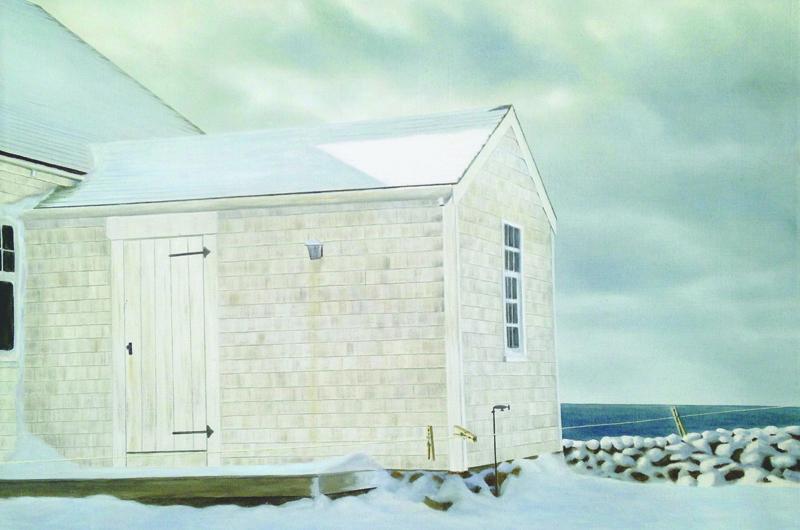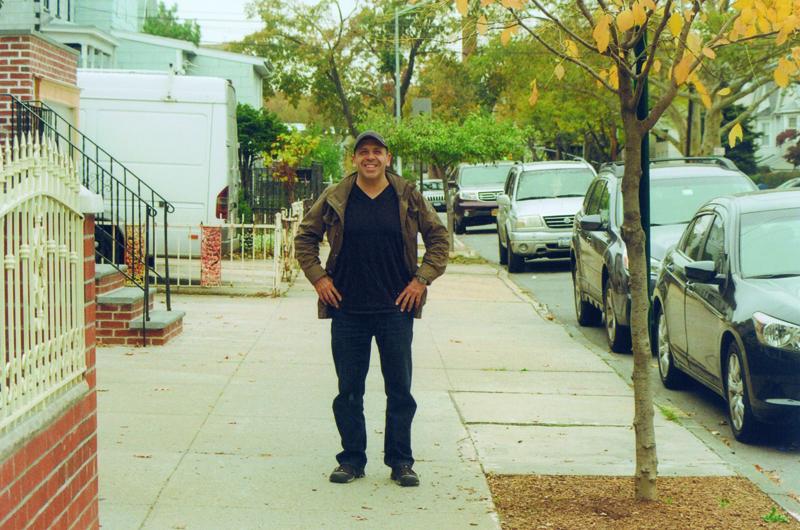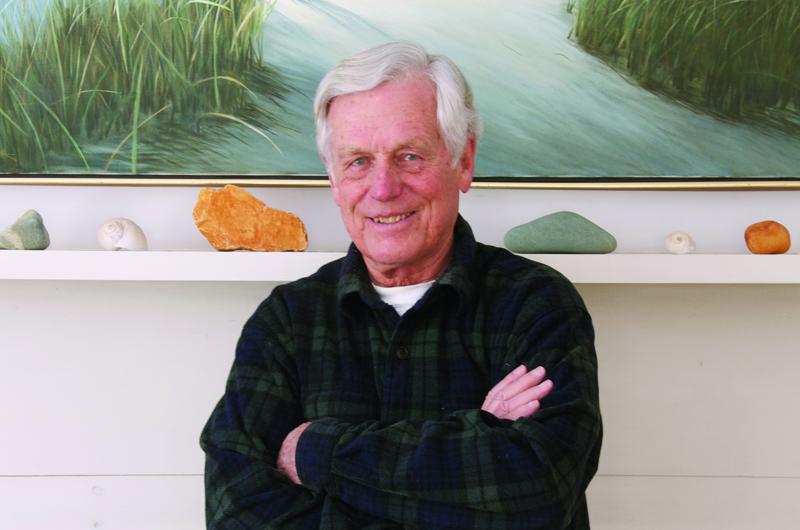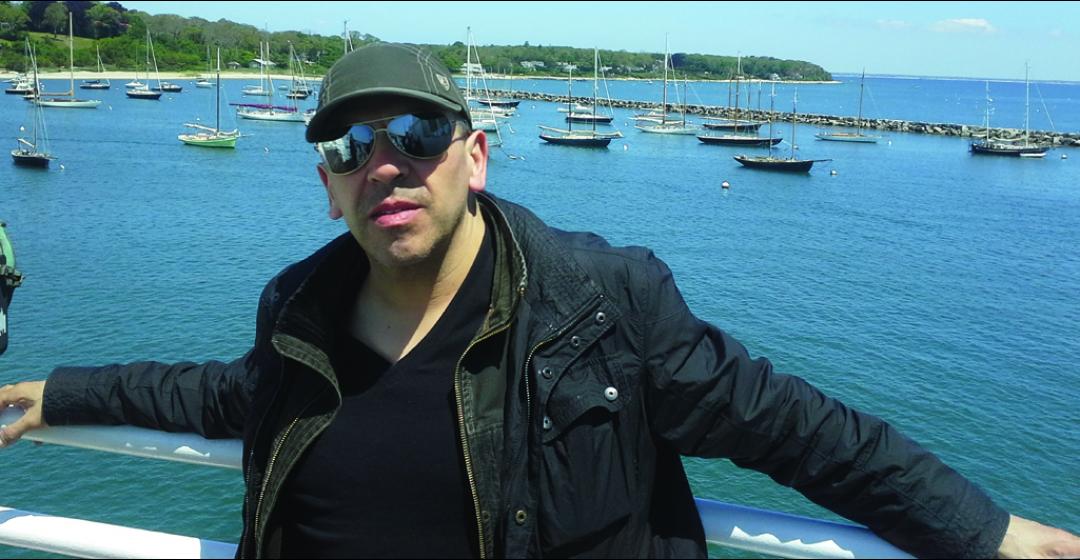It had been a long night at the television studio and Anthony Arza was tired.
It was Wednesday, May 28, 2014, he remembered, and he’d been at work since three or four in the morning. Now it was approaching eleven and beginning to drizzle. He felt lucky to have found a parking spot a block from his house, and he just wanted to get home and go to bed. So it would have made sense for him to walk right by the painting, slotted between the garbage cans on the sidewalk, but something about the landscape on the canvas – the strangely beautiful whiteness of the snow, perhaps – caught his eye.
“I dunno – what possessed me that day to even look?” Arza asked last fall, retracing his steps down 39th Avenue in Woodside in the heart of Queens, New York. “I cross the street, and I’m coming down this way, and right in front of this house here the garbage was out. It was collection day. There were some paintings out. It had just started raining. I saw the silhouette, it was a beautiful color, and it caught my eye from a ways off. I said, ‘Hm. Why is anybody throwing this out?’”

Arza is forty-seven years old and stocky, a Local 1 stagehand who hangs and focuses lights for Good Morning America at the Times Square studio in Manhattan. He was wearing a black leather jacket, jeans, cap, and a gold stud in his ear as he stood in front of the house six months afterward and recalled how he found a winter scene by the Island artist Kib Bramhall tossed out with the trash, waiting for a compactor to roll up as the rain began to fall. Arza speaks fast, his voice rasps when he gets excited, which is often, and his accent could put Archie Bunker’s to shame.
“It’s tucked in between, like, garbage cans. It was sticking out right here. I was seeing the colors walking towards it. I said, ‘Whoa, that’s really nice.’ I don’t know what possessed me, I went back and pulled it out and I said, ‘Wow. This is a cool painting, I should keep this, it’s really nice.’” On the back, stenciled on the framework, he found the title First Snow and the artist’s name.
“So, today’s technology, I took out my phone, and I said, ‘Let me Google Kib Bramhall. I have no idea who this gentleman is, but he’s a great painter.’ So I Google it, and it takes me right to the Granary Gallery [in West Tisbury]. I start seeing his pictures, and I says, ‘Wow, they’re fetching a pretty good amount of money here.’ I said, ‘I may be onto something!’” He took the painting, walked the rest of the block home, and in his living room looked at it more closely.
It featured the ell of an old house, the shingles painted white, carpeted all around by snow and shadowed by clouds, perhaps from the departing storm. In the background ran a stone wall frosted by snow, and beyond a stretch of cold water. In the foreground, out of time for the season, hung a few clothespins on a line. The way Arza remembered it, the contrasts of whites, grays, and blues entranced him. He felt like the painting took him in, like he was actually standing on the hill, in the snow, himself.
The left side of the frame was missing, but although a stain or two blemished the house as well as the snow in a corner of the canvas, the drizzle had done no real damage. He thought it couldn’t have been out on the street more than an hour. But he also figured that in another hour, a garbage truck would have come along to crush and heap it onto one of the steaming landfills outside the city.
Arza called the Granary Gallery. He said he had a painting by Bramhall called First Snow – he did not say where he found it – and what did they know about it and might they be interested in buying it? The Granary Gallery, housed in a red barn, stands at the intersection of Old County Road and Scotchman’s Lane in West Tisbury. It represents international painters and photographers, among them Thomas Hart Benton and Alfred Eisenstaedt, as well as Alison Shaw, Stan Murphy, Ovid Ward, and Bramhall, among other notable Vineyard artists.
The young man who answered Arza’s call was Adam Smith, who works with Chris Morse, who has co-owned the gallery with his wife Sheila since 1996. People often call the Granary to ask about the provenance and value of paintings inherited, or bought cheap, or found under the eaves in an attic. So there wasn’t anything terribly unusual about a guy from Queens calling to ask about a painting from the Vineyard.
At least not yet.

When Bramhall learned that First Snow had been found in the curbside trash in Queens, he felt “mortified that someone would treat the painting that way,” he said over lunch at the Atlantic restaurant on the Edgartown waterfront. “I’ve had a couple of paintings stolen out of galleries over the years, and I was quite proud of that. That someone would risk going to jail to have one of my paintings. And this is just the opposite.”
Bramhall, who is eighty-two, first came to the Vineyard with his mother in 1945, arriving twenty-four hours after VJ Day. He was a seasonal resident until he and his wife, Tess, moved year round to West Tisbury in 1980. He sold his first painting on the Island in 1957. His work is precise, layered and feathered into breaking surf, or flowers crawling over the crest of a dune, or clothespins on a line hanging this way and that in winter. Almost better known on the Island as a fisherman than a painter, he is also the author of Bright Waters, Shining Tides, a collection of his artwork and fishing essays published in 2011.
Bramhall recalled finding the house depicted in First Snow in 1985, just off the road leading down to Menemsha. “I remember painting it, and I remember liking it very much, because it’s quite a daring painting, in that the colors are mostly all degrees of white. Which is not an easy thing to do,” he said. It hung during his second show at the highly regarded Coe Kerr Gallery in Manhattan, which has since closed.
“So I was on top of the world, and also I was challenged, because I was competing in the art capital of the world with, God knows, all the talent around. It was intimidating. I was trying to establish a place in the art world simply by expressing all the emotion I felt about the Vineyard and about light in particular. And about the fact that I still had good eyes then, and I could do small detail. I don’t know where you’d put it in the whole pantheon of my work, but it did come in the middle of my most productive and successful period. So I would call it a major painting.”
First Snow, however, did not sell in New York, and Bramhall brought it home and eventually sold it to Anthony M. (Tony) Fisher, a commercial real estate developer in New York City and owner of Blue Heron Farm on Town Cove in West Tisbury, where the Obama family stayed during three of their vacations. After he purchased it, Fisher took the painting to Manhattan, where it may have hung in his office or the family apartment. Tragically, Fisher, his wife Anne, and four other people were killed when their chartered plane crashed in Leominster on April 4, 2003. He was fifty-two at the time, the father of five children who survived him, and was warmly regarded on the Vineyard for his quiet philanthropy, including his leading effort to save Martha’s Vineyard Hospital from bankruptcy in the late 1990s.
What happened to First Snow between Fisher’s death in 2003 and the discovery of it on the street in Queens in 2014 is unknown. The executor of the Fisher estate is dead, and neither his children nor the residents of the home on 39th Avenue where the painting was found could be reached to discuss it. Yet Chris Morse of the Granary Galley has seen this sort of thing before.
“I can imagine it being in a home that was being cleared out, and the simple fact that it was in a damaged frame – to a non-educated person, then that belittles it to ‘no quality,’” he said. “I’ve been in enough homes that are being cleared out when they’re trading hands, with artwork stacked behind couches, and I’ve hauled out pictures to see what’s good and what’s not good – prints, posters, or are they numbered lithographs that have value. People look at a Tom Benton that’s got a little yellowing and they’re going to throw it away because it’s a little yellow and it’s not a cheerful scene. That happens all the time.”
Morse and his employee Adam Smith studied the photos Arza sent. They could tell right away it was a Bramhall from the pinnacle of his career. Yes, part of the frame was missing and a few streaks of grime might be a challenge to remove, but the damage did not look too bad. Without yet knowing that the painting had been found on the street, Morse told Arza that it was probably worth $7,000 in the marketplace, and that he would offer $3,000.
“I’m on my way!” Arza cried into the phone, and the next thing he did was call his friends Deanna and Marty and prepare them for a long drive east.
Deanna Quinn and her fiancé Marty Lawler also live in Woodside. Arza, a lifelong friend of Deanna, knew both were always up for an adventure, and besides it would be a two-day trip and he needed them to split the driving. “C’mon, we’re taking a road trip, guys,” Arza remembered saying when they answered the phone. “You ever been to Martha’s Vineyard? They said, ‘No.’ I said, ‘Neither have I, we’re going now!’”
Arza had pictures of the painting on his phone and, thrilled by the interest of the Granary and the prospect of the trip, was showing them to friends all over the place. The response was almost universal: If the thing was worth three grand now, Arza should wait for the painter to die, whereupon it would be worth more. Arza was indignant.
“I said, ‘That’s such bad karma! I need to get this thing out of my hands. I’m not saving the painting hoping someone dies and I can get more for it. Let it go to where it belongs.’” The whole idea still shocked him six months later: “I could have harbored it and held it and bragged about it, but I needed the cash, and I figured I’m going to have a really good story after this is done.”
Quinn, Lawler, and Arza left Woodside Friday afternoon, May 30, and arrived in Woods Hole too late to catch the last ferry. They spent the night at the Woods Hole Inn, sailed to Vineyard Haven the next morning, and traveled to West Tisbury with First Snow wrapped in blankets and pressed between Arza’s legs in the back of a crowded No. 3 Vineyard Transit Authority bus. At a rise in Old County Road, they got out and walked into the red barn of The Granary Gallery.

“I was sort of surprised to see him. I talked with him the day before and then they were here,” Chris Morse recalled of the sudden arrival of Arza and his friends at the gallery with the painting in tow. He and Adam Smith were at that moment busy talking with other clients, but Arza was more than happy to look around. “It was like I was walking into a kaleidoscope,” Arza said. “The visual stimulation and the lighting in that place was amazing.”
Eventually Morse and Smith managed to break away, meet Arza, and get a first real look at the work. It was indeed a Bramhall from the height of his career. In a low voice, Morse asked where the painting had come from – the implication being, Arza felt, that it might be hot. Happily joining in the conspiratorial spirit, Arza lowered his own voice and said, “You’re not going to believe this: I found it in the garbage. Ready to be taken to the dump. It would have been crushed, it would have become landfill. It was on its way.”
The tale of a curbside rescue charmed Morse: “It makes it a more storied painting. Anything that’s been published has a little more gravity to it, I think. It’s a good painting that hasn’t been seen by a lot of Kib’s fans.” The damage looked minor and Morse thought the restoration would be easy. “An oil painting can take a punch. A landfill would be tough, but what happens [in the rain] is that the linen – it’s painted on linen, not canvas – will tighten up. But it won’t in any way assault the pigment. Not that I would encourage it.”
He wrote Arza a check for $3,000, which might have squared everything away. But for Arza there was one thing left to do. He bought a copy of Bramhall’s book, on sale at the gallery, and left it with Smith and a note asking the artist to inscribe Bright Waters, Shining Tides and send it to him in Queens. With that, the New Yorkers left. Arza had been on the Island two hours, but he had to get back – work and other business was calling. “I would have loved to have hung out,” he said. “I had too much going on. I said I’ll be back to enjoy it someday.”
It wasn’t hard for Bramhall to restore First Snow. Thirty years later, he happened to have one last length of wood from the original frame, which replaced the missing piece. The blemishes were easy too. “I have a trick about restoring paintings, and it’s to use a white handkerchief and saliva, and I can clean anything off a canvas that way,” he said. “I once went to the restoration gallery of the Uffizi in Florence and watched them clean paintings, and I told them my method, and they said, ‘That’s really the best, because the enzymes in your saliva will take care of almost anything.’”
He still admired the work. “I would do it the same way if I could,” he said. “I had the painting in my house for a few days when I was restoring it for Chris, and hung it here and there in the house, and it held up extremely well with all of the rest of my work that I have here. And I was very proud of it.”
Chris Morse admired it too, so much so that he planned to hold on to it. “I don’t know that I will sell it,” he said, though he’d consider parting with it if it turned out someone in the Fisher family wanted it. “Do a trade,” he said. “Art should go back to the family, if the family wants a piece that has meaning to them.”
And Anthony Arza? The check from the gallery, plus the sale of an old BMW, earned him the money he needed to pay the closing costs and down payment on a house in North Adams, Massachusetts. He had been in the process of figuring out how to finance the purchase when the painting turned up on the sidewalk in front of him as if on cue. “Things have always come to me very easily,” said Arza, who calls himself a born optimist. “And I know it. That’s why I never worry.”
The bank that was writing the mortgage, on the other hand, was skeptical of the sudden injection of funds into his account. “What’s this $3,000 check?” the loan officer asked Arza. “I told them the story, they’re like, ‘Oh, yeah. Okay. You found a painting in the garbage.’ So they had to contact the gallery and get a reply from the owner that he did in fact buy the painting off of me.”
Also, Bramhall inscribed the book, thanking Arza for saving the painting from the landfill. Which means Arza, sipping a coffee at a Starbucks a few blocks from his house in Woodside last fall, had no regrets about any of it.
“I have more than the painting could ever earn,” he said. “I have the interaction with Kib, the artist himself. I have you here now, writing this up, which I wouldn’t have imagined. The story was amazing.” He looked at the painting on his phone, shook his head, and his voice rose as he laughed and said, “I tell people the story, they don’t believe it!”




 6 comments
6 comments
Comments (6)